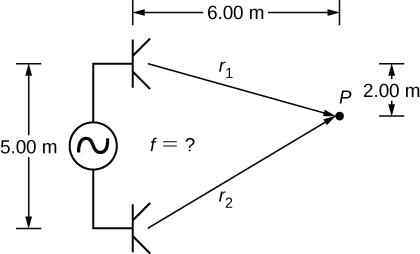| << Chapter < Page | Chapter >> Page > |
The phase difference at each point is due to the different path lengths traveled by each wave. When the difference in the path lengths is an integer multiple of a wavelength,
the waves are in phase and there is constructive interference. When the difference in path lengths is an odd multiple of a half wavelength,
the waves are out of phase and the result is destructive interference. These points can be located with a sound-level intensity meter.


Check Your Understanding If you walk around two speakers playing music, how come you do not notice places where the music is very loud or very soft, that is, where there is constructive and destructive interference?
In the example, the two speakers were producing sound at a single frequency. Music has various frequencies and wavelengths.
The concept of a phase shift due to a difference in path length is very important. You will use this concept again in Interference and Photons and Matter Waves , where we discuss how Thomas Young used this method in his famous double-slit experiment to provide evidence that light has wavelike properties.
[link] shows a clever use of sound interference to cancel noise. Larger-scale applications of active noise reduction by destructive interference have been proposed for entire passenger compartments in commercial aircraft. To obtain destructive interference, a fast electronic analysis is performed, and a second sound is introduced out of phase with the original sound, with its maxima and minima exactly reversed from the incoming noise. Sound waves in fluids are pressure waves and are consistent with Pascal’s principle; that is, pressures from two different sources add and subtract like simple numbers. Therefore, positive and negative gauge pressures add to a much smaller pressure, producing a lower-intensity sound. Although completely destructive interference is possible only under the simplest conditions, it is possible to reduce noise levels by 30 dB or more using this technique.

Notification Switch
Would you like to follow the 'University physics volume 1' conversation and receive update notifications?